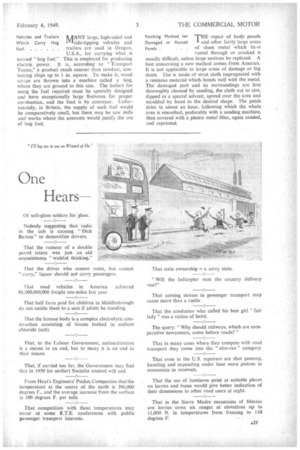Passing Comments
Page 2

Page 3

If you've noticed an error in this article please click here to report it so we can fix it.
When Mobile Publicity May Involve Some Danger THE publicity afforded by I commercial vehicles is often of considerable value.
Unlike a stationary display,
which is seen by only a proportion of those people who pass, the mobility of a vehicle ensures that any name, or particularly attractive signwriting or other pictorial publicity on it, will be brought -before the eyes of many thousands of people along its whole route. There is, however, one• problem which is facing those, mainly ancillary users, whose vehicles carry unusually valuable loads, or commodities in short supply. To advertise on a vehicle the name of a concern which is well known as the purveyor of such goods is to indicate to potential thieves where their. activities may be directed ' to the greatest advantage, whereas a plain van Might -contain goods of no special interest to them, or at least would -require closer investigation to ascertain whether they were worth the trouble and risk involved. Already some thieves of complete vehicles have been bitterly disappointed when they discovered the value of their " hauls."
A26 A Study of Advertise menu is Often In structive
A TWERTISEMENTS some
"times contain quite a useful
amount of technical and general information. One issued by Solex, Ltd., gives general notes on the result of excessive spee.4 It points out that, on the average, a 30 h.p. engine consumes 25 per cent. more fuel at 60 m.p.h. than at 40 m.p.h. As regards oil consumption, at 55 m.p.h. this can be seven times as great as at 30 m.p.h., even with an engine in first-class condition. Speed naturally affects tyre wear, which is frequently doubled when the rate of travel is raised from 30 m.p.h. to 60 m.p.h. Attention is also drawn to the significance of those black tyre marks so often seen on the road. They indicate an excessive loss of rubber, Stress on brake facings and -drums, and violent braking, which may loosen body and chassis
bolts, tear rivets and strain springs. One point, however, rather puzzles us. It is claimed that such braking will strain the transmission from the flywheel to the back 'axle. -In our view, this would , occur only if a powerful transmission brake were to be employed. Vehicles and Trailers Which Carry Hog Fuel MANY large, high-sided and
side-tipping vehicles and trailers are used in Oregon, U.S.A., for carrying what is termed "hog fuel.This is employed for producing electric power. It is, according to " Transport Topics," a product much coarser than sawdust, containing chips up to I in. square. To make it, wood scraps are thrown into a machine called a hog, where they are ground to this size. The boilers for using the fuel required must be specially designed and have exceptionally large fireboxes for proper combustion, and the feed is by conveyor. Unfortunately, in Britain, the supply of such fuel would be comparatively small, but there may be saw mills and works where the amounts would justify the use of hog fuel.
Fuel
Patching Method for THE repair of body panels Damaged or Rusted L and other fairly large areas
Panels . . . . of sheet metal which have rusted through or cracked is usually difficult, unless large sections be replaced. A hint concerning a new method comes from America. It is not applicable to large areas of damage or big dents. Use is made of stout cloth impregnated with a resinous material which bonds well with the metal. The damaged part and its surroundings are. first thoroughly cleaned by sanding, the cloth cut to size, dipped in a special solvent, spread over the area and moulded by hand to the desired shape. The patch dries in about an hour, following which the whole area is smoothed, preferably with a sanding machine, then covered with a plastic metal filler, again sanded, and repainted.


























